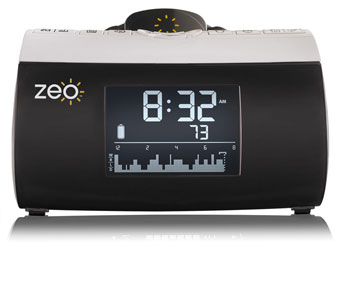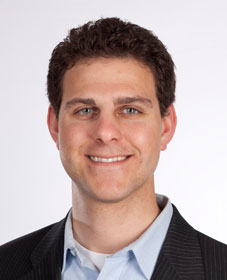 In the fall of 2003, during an introductory psychology class at Brown University, a group of students learned that when an alarm clocks wakes you up during the wrong sleep stage, you wake up feeling groggy. If the alarm clock happens to wake you during the right sleep stage, however, you awake feeling refreshed.
In the fall of 2003, during an introductory psychology class at Brown University, a group of students learned that when an alarm clocks wakes you up during the wrong sleep stage, you wake up feeling groggy. If the alarm clock happens to wake you during the right sleep stage, however, you awake feeling refreshed.
"It is a very powerful idea," Zeo co-founder and chief technology officer Ben Rubin told MobiHealthNews during a recent interview. "College students wake up feeling horrible everyday and the opportunity of waking up feeling refreshed everyday is one that has a lot of appeal to it from a consumer perspective. So, after that class a group of us got together around a kitchen table wondering how we could make this work."
Zeo co-founders Jason Donahue, Ben Rubin and Eric Shashoua and half a dozen others brainstormed ways to find a way to wake someone up feeling refreshed. The group first wondered whether they could predict which sleep stage the sleeper was in based on a timer -- based on what time they fell asleep. After consulting the research, however, they quickly realized that the alarm clock would have to know which sleep phase the person's brain was in and they set about interviewing sleep scientists at Brown and Harvard to see if it was possible.
 "When we asked how do we phase sleep in the home the answer was always: 'Here's how you do it in the lab,' which is always expensive and uncomfortable. It also required wet paste electrodes," Rubin explained. "If you took five guys from the medical world of sleep science and told them to try to build something that could phase sleep at home, they probably wouldn't get past the wet paste electrodes. We were lucky that we didn't have their experience. We decided we would try to do it anyway."
"When we asked how do we phase sleep in the home the answer was always: 'Here's how you do it in the lab,' which is always expensive and uncomfortable. It also required wet paste electrodes," Rubin explained. "If you took five guys from the medical world of sleep science and told them to try to build something that could phase sleep at home, they probably wouldn't get past the wet paste electrodes. We were lucky that we didn't have their experience. We decided we would try to do it anyway."
The Zeo team began looking at materials they could use for the sensors, including conductive rubbers and carbon fiber. Eventually they came across a wound dressing fabric that includes silver because of its antimicrobrial properties. Silver is also conductive and, what's more, this wound dressing material was comfortable against the skin. That's where the fabric Zeo uses in its headband sensor originated.
Before the Zeo team had graduated from Brown ('05), it had secured grants from the Brown Entrepreneurship program ($5,000) and a grant from the National Collegiate Inventors and Innovators Alliance, or NCIIA ($35,000) that enabled them have stipends to live off of while they slept in friends' attics at night getting -- presumably -- a good night's rest while they worked to bring their product into commercial development by day. Rubin and the team used the NCIAA grant to build the first Zeo prototype.
"It was ugly," Rubin said. "It was an Adidas sports headband that one of our engineers sewed the silver pads onto. It was full of wires."
As school drew to a close, Zeo began its search for an advisory board.
"Sometimes it's advantageous to be a young entrepreneur. People are happy to help," Rubin said. "It's even better to be a young, student entrepreneur."
So Rubin began "cold-calling" the founder, chairman and CEO of iRobot, Colin Angle. iRobot, of course, is the $300 million "practical robots" like its robot vaccuum, Roomba. Zeo was interested in Angle for an advisory role because his Boston-based company was close to Zeo's (original) HQ in Providence and because Angle was one of the few entrepreneurs to start a consumer electronics company in the area and find success.
After seven cold calls to Angle's office, Rubin managed to win a meeting with Angle who quickly became a believer in Zeo. Angle joined Zeo's board of directors and helped the startup secure venture funding. Indeed, three of Zeo's board members are also board members for iRobot thanks to Angle, Rubin said.
With its new connections and developing product, Zeo next secured two rounds of venture capital funding, which included some of the same major backers that financed iRobot. With the new venture capital money the startup hired an experienced CEO, Dave Dickinson, who counts 25 years of experience at various startups and established firms, including Johnson & Johnson. Rubin credits Dickinson with helping the company better understand its customers, forging relationships with key scientific resources building out its sales and marketing teams.
As Zeo began testing its prototypes with consumers the startup's plans to make its central offering a "smart alarm clock" that helped users wake up at optimal times began to change. The smart alarm was no longer the thrust of the company. Consumers were more interested in how well they slept and how they might be able to sleep better, so the smart alarm feature became a welcome bonus.
"We went through a major shift," Rubin said. "We went from a company that was all about waking up to a company that was all about sleep. Consumers told us that they loved the smart wakeup, but they wanted to know more about how they could get more REM and deep sleep. They wanted explanations for why they woke up seven times last night and how they can improve that. So we set about creating not just a smart alarm clock, but a personal sleep coach that would show you what was affecting your sleep and suggest improvements that could be made."
Rubin said that somewhere between 30 percent and 50 percent of adult americans are not sleeping well. The reasons are varied but include being overworked, over anxious, over caffeinated or sleeping in a bedroom not conducive to sleep.
Sleep is not prioritized in our society, according to Rubin. By detecting sleep phases throughout the night, Zeo helps users measure how well they sleep in an effort to help them become accountable to themselves. On the bedside display, Zeo shows the user their composite ZQ score based on how much REM sleep, deep sleep, light sleep, total sleep and the number of times the user wakes up throughout the night.
Zeo offers these tracking capabilities but also a coaching program, which it developed with "the top sleep scientists in the world." Zeo's email based coaching program asks for various bits of relevant personal information -- everything from the number of kids a user has to their personal anxiety factors. The program sets up a baseline, tracks results and looks for consistency and improvement. Along the way users are given pointers and explanations for their results.
Zeo is a consumer product and not meant for people who have sleep disorders but rather for everyday people who have sleep problems, according to Rubin. It's not a medical device, but Rubin admits that the device could have legs in the medical field, especially research because the device's consumer price point.
Zeo became commercially available through the company's website in October.

















